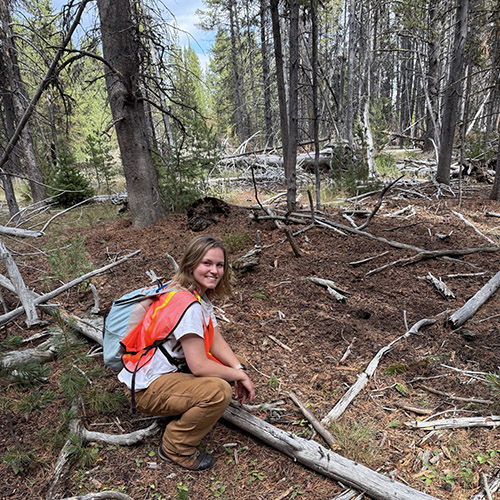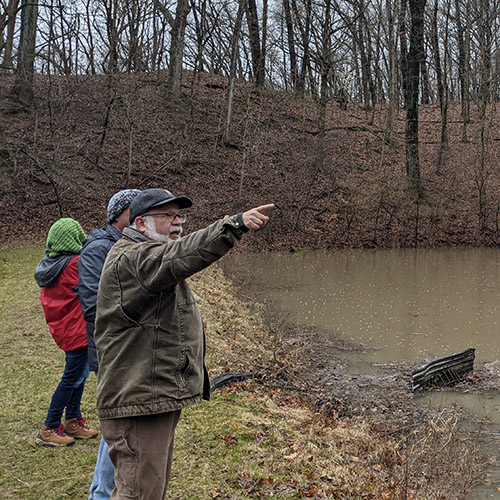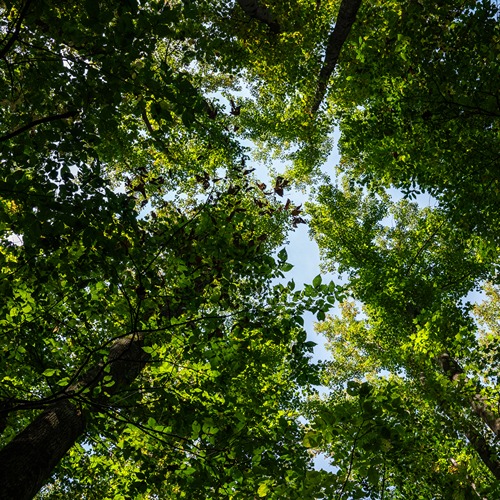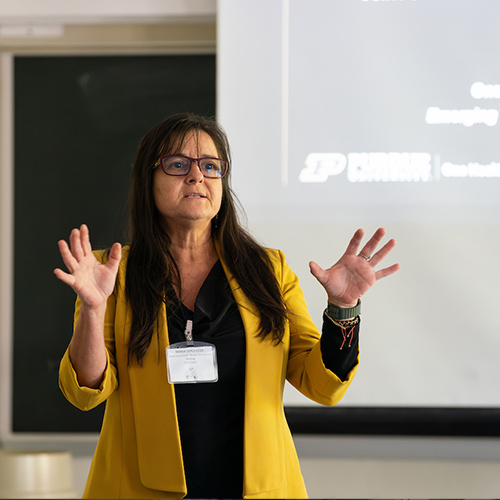FNR Field Reports: Sweden Study Abroad Week 2 Update - Jonathan Shimizu
Throughout the 2023 Sustainable Natural Resources study abroad course in Sweden, FNR students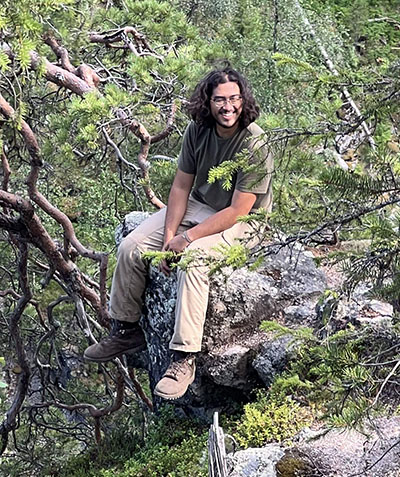 will check in to provide weekly updates on the trip highlights. Providing the Week 2 update is senior forestry: forest science major Jonathan Shimizu.
will check in to provide weekly updates on the trip highlights. Providing the Week 2 update is senior forestry: forest science major Jonathan Shimizu.
During the four-week Sustainable Natural Resources study abroad course students will examine natural resources broadly defined, including forestry, fisheries, wildlife, agriculture, mining, outdoor recreation, and urban sustainability. They will define, discover, and document examples where sustainability of resource use matters. The course explores the effect of terrain, climate, vegetation, faunal assemblages, social structures and technologies on natural resource use. FNR 46000 is a collaboration of Purdue University, North Carolina State University, and the Swedish University of Agricultural Sciences. American and Swedish students work together to research issues in resource management.
The course is co-taught by FNR's Drs. Tomas Hook, Barny Dunning and Doug Jacobs as well as other instructors from NC State and SLU.
Prelude from Jonathan: I have been having an amazing time here in Sweden! Umeå was a blast. It was a lively city with lots of great places to eat, shop, swim, and explore. Special thanks to Sara Forsman, a SLU student, for creating a detailed guide to the city!
Monday, July 10th
Today was mostly a travel day. We woke up early to make the train from Umeå to Gällivare. It was a four hour train ride with a train-change in Boden. Once we got off the train, we had to wait a while for the bus to come pick us up and take the students to their accommodations. While we waited, we took the chance to walk around the downtown area. We also took a walk by a river with a mountain in the background! Once we arrived at our cabins, we set up our rooms and then went to eat some food at a local restaurant. Afterwards, we stopped at a grocery store (COOP) and got some food and snacks for the next few days. At this point, we had also just entered the Arctic Circle, so we still had plenty of sunlight at 11 p.m.! My roommates and I played some card games until we decided to end our day and go to bed.
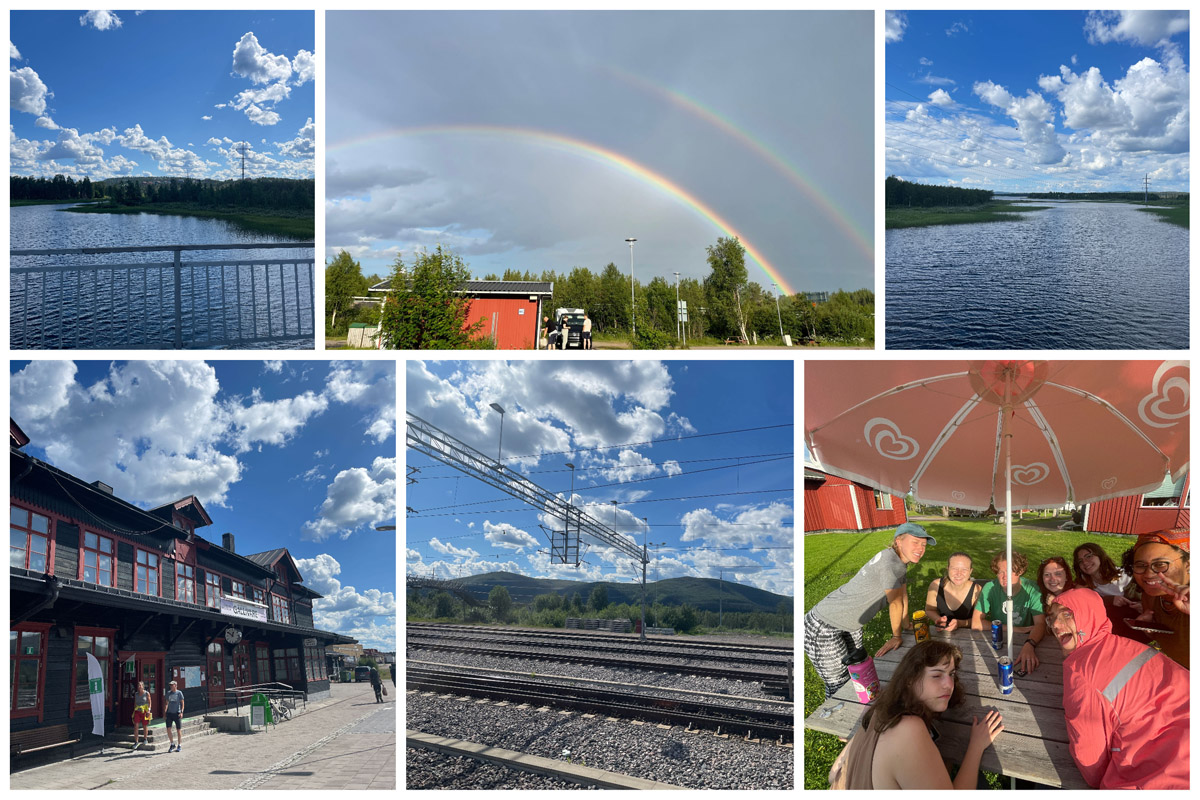 Views of the river in Gällivare, Sweden; a double rainbow over the town; the train station in Gällivare and a photo of the study abroad group hanging out after dinner under an umbrella.
Views of the river in Gällivare, Sweden; a double rainbow over the town; the train station in Gällivare and a photo of the study abroad group hanging out after dinner under an umbrella. Tuesday, July 11th
- Today our main activity was visiting the largest open-pit mine this far north, Aitik owned by Boliden AB! Here, their main export is copper, but they also dabble in silver and gold. They pay special attention to their carbon, dust, and water emissions and frequently have to conduct Environmental Impact Assessments to stay in business. They also conduct Social Impact Assessments to survey how they interact with and impact the local Sámi people. We toured their mining operation via bus, climbed on their trucks, and ate a hot lunch.
- After the tour, we visited a forest site which the Aitik mine is helping to improve via joint cooperation with the local university. They are trying to improve biodiversity by introducing insect-filled woody debris into the forest. The rest of the day consisted of relaxing back at the cabins and hanging out with the local students.
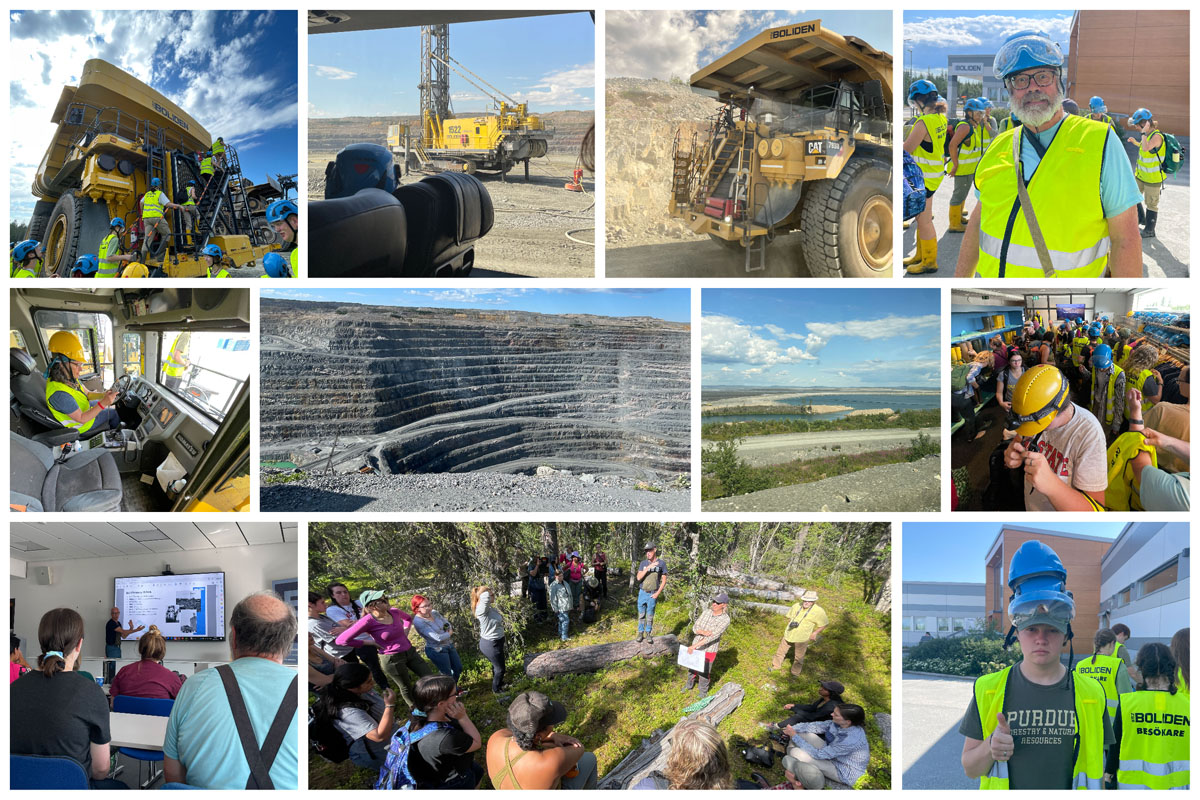 Photos from the Aitik mine owned by Boliden AB. Row 1 from left: students climbing onto a large truck, the drilling machine, Dr. Barny Dunning in his personal protective equipment. Row 2: a student in the truck cabin, the open pit mine; an on-site water holding area; students donning their PPE; Row 3: students in a lecture about mining; students at an outdoor forest field site; Keegan Abeson wearing multiple construction hats giving a thumbs up.
Photos from the Aitik mine owned by Boliden AB. Row 1 from left: students climbing onto a large truck, the drilling machine, Dr. Barny Dunning in his personal protective equipment. Row 2: a student in the truck cabin, the open pit mine; an on-site water holding area; students donning their PPE; Row 3: students in a lecture about mining; students at an outdoor forest field site; Keegan Abeson wearing multiple construction hats giving a thumbs up. Wednesday, July 12th
Today’s special activity consisted of visiting Muddus National Park! Our goal was to reach a beautiful waterfall at the end of the 7 km trail. 7 km doesn’t seem like a lot, but it sure felt like a lot more due to the rocky and uneven terrain. Along the way, we stumbled across some reindeer and some awesome sights. We ate lunch at the waterfall and quickly headed back to the trailhead so we could make it back to our cabins in time. By the end of the day, I had hiked around 16 km and stumbled across another group of reindeer.
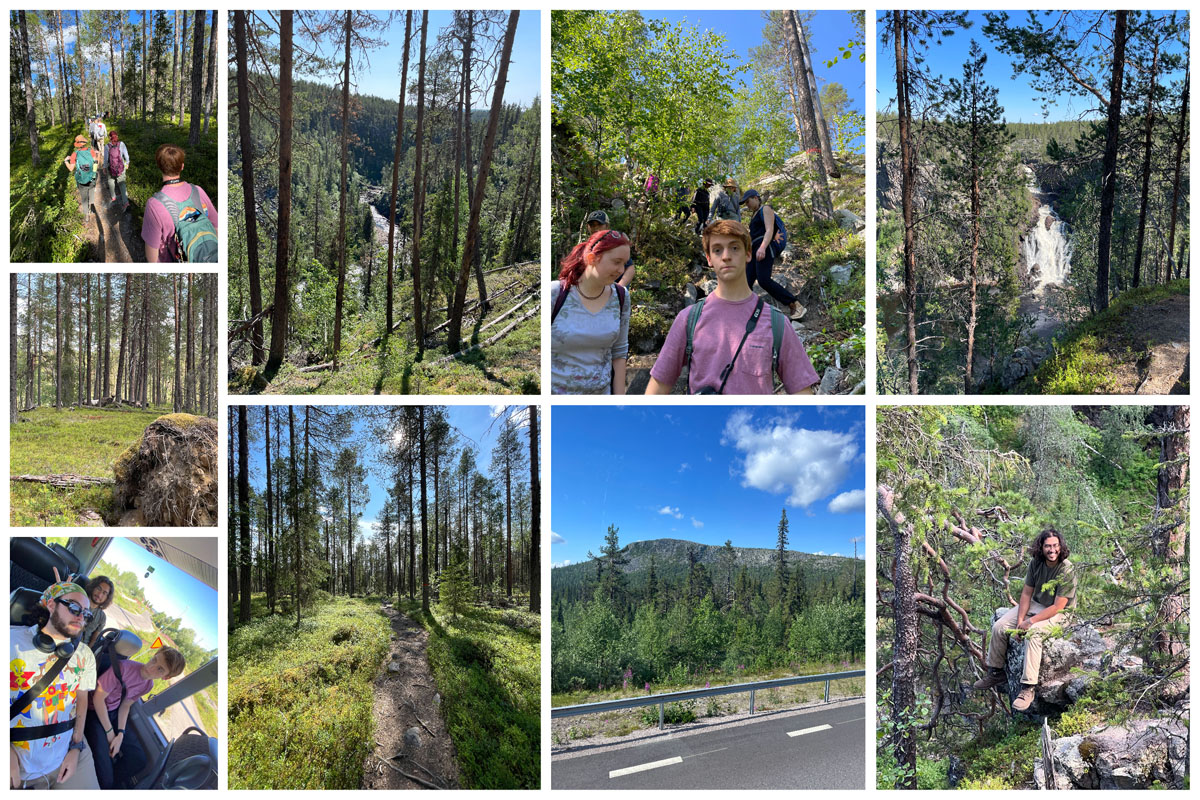 Views from Muddus National Park in Sweden, including students on the trail, a view of the river, a view of students climbing down the hill and a view of a waterfall. Row 2: a reindeer herd. Row 3: students on the bus; a path through the forest, a mountain in the distance and Jonathan Shimizu sitting on a rock
Views from Muddus National Park in Sweden, including students on the trail, a view of the river, a view of students climbing down the hill and a view of a waterfall. Row 2: a reindeer herd. Row 3: students on the bus; a path through the forest, a mountain in the distance and Jonathan Shimizu sitting on a rock Thursday, July 13th
Today we traveled from Gällivare to Kiruna via bus. The old city center where we stayed was a bit… empty. Lots of buildings were empty, closed, or abandoned. This is because Kiruna is currently in the process of relocating it’s city center and southwest portion of the city to a new area. This is due to the local shaft mine expanding it’s mining operations closer to the city. The mining company has determined that more iron can be found closer to the city. So for the safety of the people living in that section of Kiruna, it was decided that they will need to relocate. This issue is too complex to explain in detail here, but the jist of it is that Kiruna needs the mine, and the mine needs Kiruna to survive. They have been integral to each other’s growth and prosperity, so it is difficult for one to abandon the other. To better understand this, an SLU student (Sara again), set up a meeting with the city planners in the evening. During this meeting, we got to see how the city plans to relocate and how the city government is handling the change. However, it would be interesting to see how the relocated citizens feel about this issue. We ended the day with a nice dinner at a local restaurant where I ate a waffle with smoked reindeer salad and fish roe.
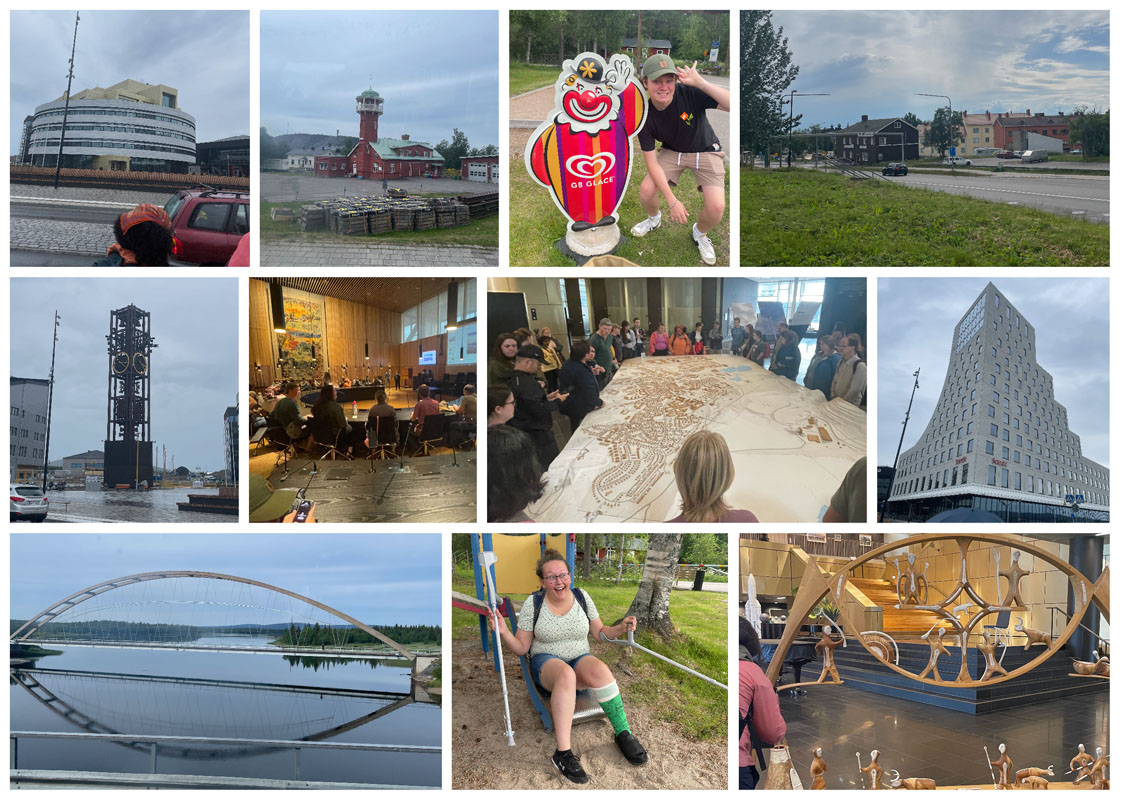 Photos from Kiruna, Sweden. Row 1: The new city hall building; the old city hall building; Keegan Abeson posing with an advertising sign of a clown; a view of the town of Kiruna; Row 2: the relocated clock tower; students in a meeting room; students with a miniature model of Kiruna; a new building adjacent to city hall; Row 3: a bridge spanning the river; Alex Dudley sitting on a slide; a piece of art in city hall.
Photos from Kiruna, Sweden. Row 1: The new city hall building; the old city hall building; Keegan Abeson posing with an advertising sign of a clown; a view of the town of Kiruna; Row 2: the relocated clock tower; students in a meeting room; students with a miniature model of Kiruna; a new building adjacent to city hall; Row 3: a bridge spanning the river; Alex Dudley sitting on a slide; a piece of art in city hall. Friday, July 14th
Today was a bit of a shorter day. I started off by eating the hostel breakfast, visiting some local shops and eating a nice lunch. We then took a bus to tour the LKAB iron shaft mine and learn about their operation and future plans. The bus took us beneath the mountain were LKAB is mining, down to tourist center about 500 meters below the old peak of the mountain, or “point zero”. The mine is currently operating at below 1200m and has plans to expand deeper. They mainly use remote-controlled machinery to mine at these deep depths. We went on a walking tour explaining their machinery, their mining process, and the issues they faced when trying to expand closer to Kiruna. Once the tour was over, we went back to the hostel to relax. This was the day when I explored the wonders of the sauna, and I would use it twice this day.
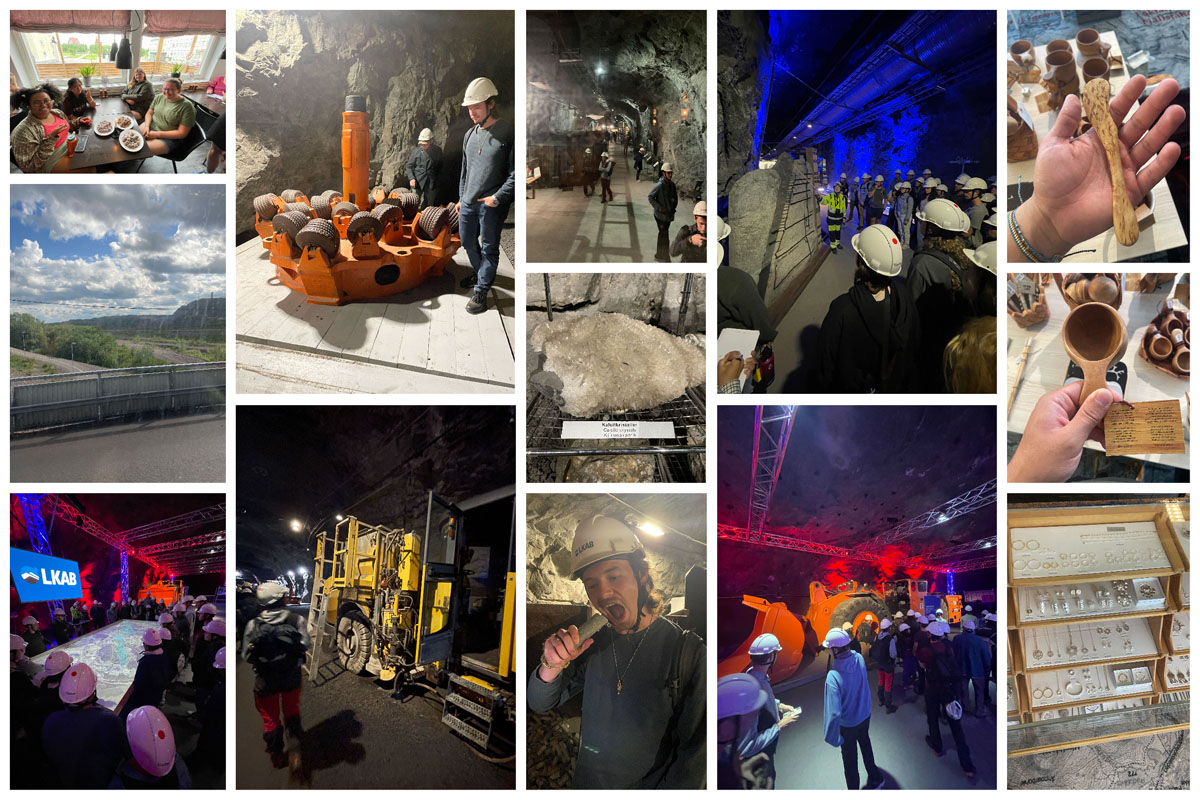 The LKAB Iron Shaft Mine in Kiruna. Row 1: Students enjoy breakfast; a student next to a drillhead; students next to an old train car; students viewing the mine plan; a birch knife; Row 2: a view of the mine; calcite crystals; a kuksa; Row 3: students look at iron deposits; students with mining machinery; a student pretends to bite a rock; students with more mining machinery; a case of jewelry
The LKAB Iron Shaft Mine in Kiruna. Row 1: Students enjoy breakfast; a student next to a drillhead; students next to an old train car; students viewing the mine plan; a birch knife; Row 2: a view of the mine; calcite crystals; a kuksa; Row 3: students look at iron deposits; students with mining machinery; a student pretends to bite a rock; students with more mining machinery; a case of jewelry Saturday, July 15th
This was our last full day in Kiruna! We visited a local Sámi living museum. The best way I could relate this to something we have in Indiana is Conner Prairie. Not to say that they’re 1:1, since they’re not, but the idea is similar. This museum had a herd of reindeer, old Sámi buildings, and a gift shop and restaurant. Our tour guide explained that the museum was established to teach the populace about Sámi culture and traditions. We also got to hear about the relationship between the mines, particularly LKAB, and the Sámi people.
That’s all I have! I'll let Arlene talk all about Abisko!
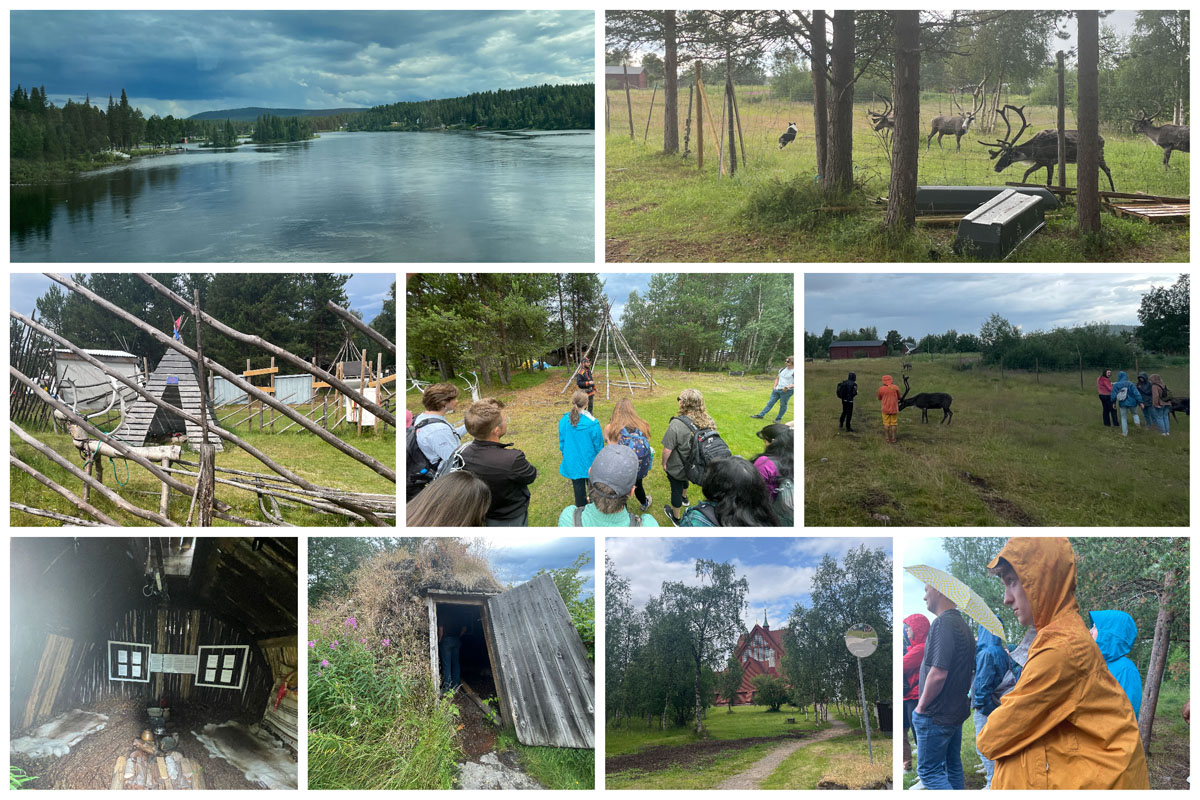 Sámi living museum: Row 1 - a view of the lake; a herd of reindeer; Row 2 - historic buildings on site; the group with a guide; up close with the reindeer; Row 3 - house interior; historic Sami house; an old church; students in rain gear
Sámi living museum: Row 1 - a view of the lake; a herd of reindeer; Row 2 - historic buildings on site; the group with a guide; up close with the reindeer; Row 3 - house interior; historic Sami house; an old church; students in rain gear 
